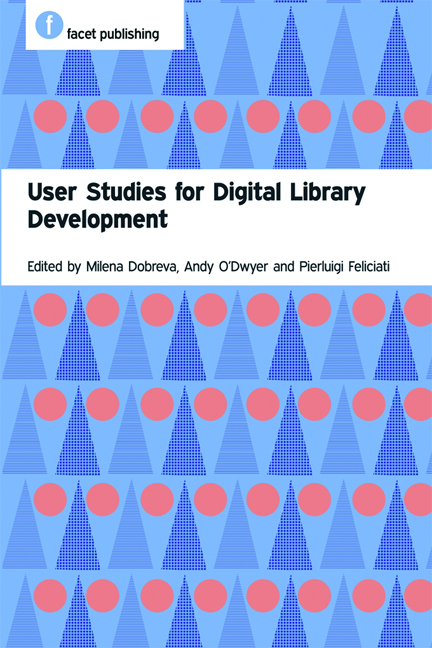Book contents
- Frontmatter
- Contents
- Preface
- Acknowledgements
- Abbreviations
- Glossary
- 1 Introduction: user studies for digital library development
- PART 1 SETTING THE SCENE
- PART 2 METHODS EXPLAINED AND ILLUSTRATED
- 6 Questionnaires, interviews and focus groups as means for user engagement with evaluation of digital libraries
- 7 Expert evaluation methods
- 8 Evidence of user behaviour: deep log analysis
- 9 An eye-tracking approach to the evaluation of digital libraries
- 10 Personas
- PART 3 USER STUDIES IN THE DIGITAL LIBRARY UNIVERSE: WHAT ELSE NEEDS TO BE CONSIDERED?
- PART 4 USER STUDIES ACROSS THE CULTURAL HERITAGE SECTOR
- PART 5 PUTTING IT ALL TOGETHER
- Index
8 - Evidence of user behaviour: deep log analysis
from PART 2 - METHODS EXPLAINED AND ILLUSTRATED
Published online by Cambridge University Press: 08 June 2018
- Frontmatter
- Contents
- Preface
- Acknowledgements
- Abbreviations
- Glossary
- 1 Introduction: user studies for digital library development
- PART 1 SETTING THE SCENE
- PART 2 METHODS EXPLAINED AND ILLUSTRATED
- 6 Questionnaires, interviews and focus groups as means for user engagement with evaluation of digital libraries
- 7 Expert evaluation methods
- 8 Evidence of user behaviour: deep log analysis
- 9 An eye-tracking approach to the evaluation of digital libraries
- 10 Personas
- PART 3 USER STUDIES IN THE DIGITAL LIBRARY UNIVERSE: WHAT ELSE NEEDS TO BE CONSIDERED?
- PART 4 USER STUDIES ACROSS THE CULTURAL HERITAGE SECTOR
- PART 5 PUTTING IT ALL TOGETHER
- Index
Summary
The methodology
What is deep log analysis?
Everyone who uses a digital service leaves a record of their activities on the particular platform they used, be that a mobile phone, laptop or iPad. This record, which is best thought of as a digital footprint, is automatically stored on the computer server as a log. The log provides a huge treasure trove for researchers and practitioners who are interested in how people seek, search, navigate, use and act upon information. Deep log analysis then involves processing, relating, evaluating and making sense of this data on behalf of businesses, libraries, policy makers and senior managers. It is called ‘deep’ to distinguish it from transactional log analysis, which is essentially an activity (hit or download) counter.
Deep log provides very detailed and bespoke usage analyses of digital information services of all kinds. Deep log transforms the activity data found in the logs into information-seeking and usage behaviour; then, with the aid of other information held in the logs, online questionnaires and third party data sets, like Scopus, information-seeking and use data are transformed into user behaviour by relating it to demographic, attitudinal and then outcome data, enabling satisfaction and success to be established – a real breakthrough. As we shall see, deep log analysis goes well beyond Google Analytics, the closest most people get to deep log analysis.
Why the need for deep log analysis?
Because of the massive scale and rapid speed of the digital transition, which is now impacting on all aspects of our lives (work and social), we badly and urgently need to know what is going on in the virtual information space because that is where most of the action is, and the challenge (and need for deep log analysis) is occurring remotely, anonymously and dynamically. Interviews, observation and questionnaires – the traditional library and information science (LIS) research methodologies – on their own do not work well in the digital environment because people have problems remembering when and what they did in the virtual space, which, of course, covers a myriad of platforms, including mobile and smartphones, digital interactive television, touchscreen information kiosks, and desktop and laptop computers.
- Type
- Chapter
- Information
- User Studies for Digital Library Development , pp. 85 - 94Publisher: FacetPrint publication year: 2012
- 2
- Cited by



